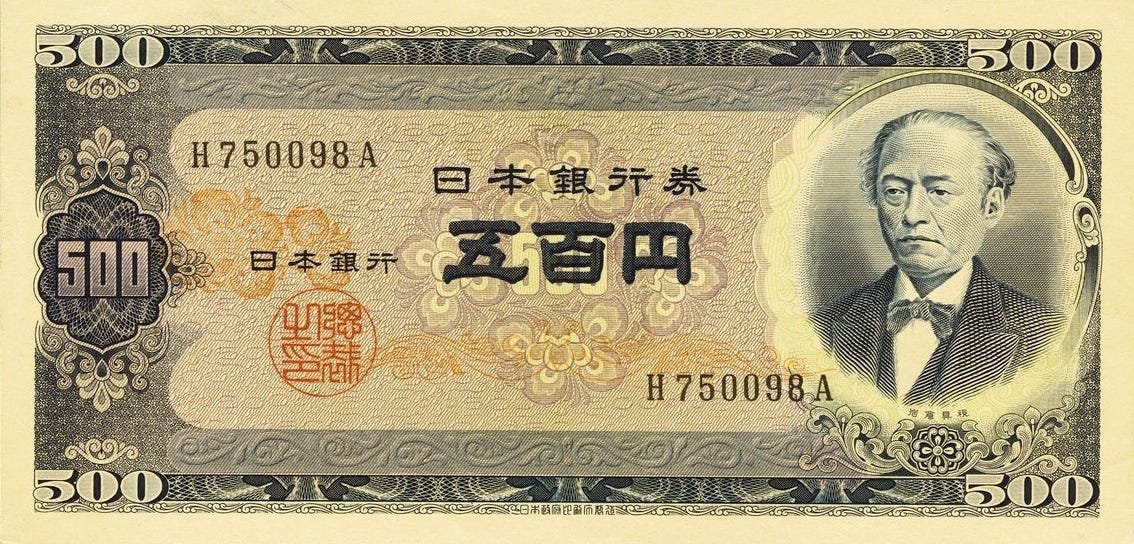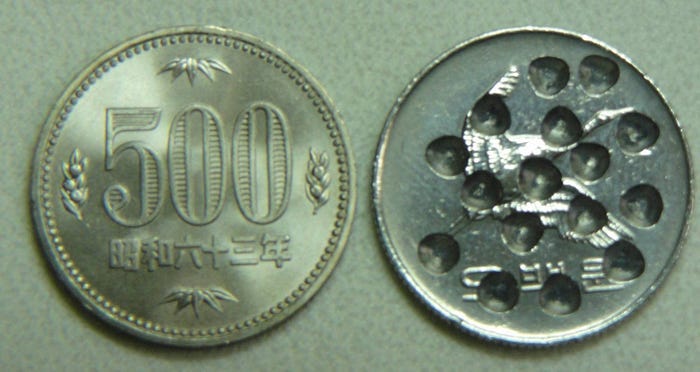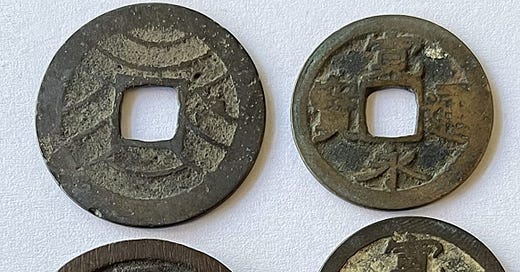It was a truly revelatory moment when Hidden Japan recently reached the 500 subscriber mark and I wanted to write a slightly self-serving post on the milestone. Searching for an appropriate topic to commemorate this, a reader suggested investigating the 500 Yen coin.
I found this the perfect symbol as mints create unique coins to mark occasions. 500 Yen is an absurdly high value for a coin (and is also a much larger readership than I expected!), but with perspective 500 Yen won’t actually take you very far. Join me to explore questions like why Japan has coins, do all coins matter, and what is the state of coin collection in Japan.
What are coins?
Back to basics, in case anyone found themselves reading a post on the 500 Yen coin and needed a refresher. Coins have been a primary form of currency exchange for thousands of years, essentially ever since a society decided that it was helpful to have some standardised value of worth. They have traditionally been made of some metal that is pressed into a mostly uniform shape. Coins exist in some form for almost every modern society with the notable exception of Burning Man once a year.
The Japanese coin system was borrowed from China’s copper coin system in roughly the 7th Century since they saw China being wealthy next door and thought, surely copying their entire financial system couldn’t hurt. Looking at a coin’s shape is usually a giveaway on which currencies are descended from Chinese coins as they resemble a more donuty shape with a hole in the middle (now Japan only “holes” the 5 and 50 Yen coins). The holes were used so that the coins could be strung on a line for ease of carry, or as a necklace to act as a very direct fashion statement on wealth.
In modern inflationary times, coins, especially those of lower monetary value (but still valuable in our hearts), have come in for questioning on whether they should still even exist. Low value coins like Japan’s 1 Yen coin are manufactured at a loss (reportedly 3 Yen each). Even as someone who doesn’t deal directly with money daily like a mint merchant, I can tell you that losing two-thirds of your investment for every product is the opposite of good business habits.
It is for this reason that many other countries (Australia, Brazil, Canada, Finland, Israel, New Zealand, Netherlands, Norway, Sweden, and Switzerland just to name a few) made the decision to cease manufacturing their lowest value currency.
Believe it or not (and it’s hard to believe when your wallet mysteriously ends up jingling with all these pieces) but the Japanese Mint officially stopped manufacturing 1 Yen coins as of 2016 (except as part of full collectible sets). But until the Japanese Government actually withdraws the coin from circulation, and exchanges the millions of solitary Yen coins that appear each shopping trip, this tiny near-worthless coin will keep floating about.
Minted and Printed
Even with low value currency losing money and strings of coins having fallen out of favour, modern mints can still make a fortune both literally and figuratively. In no small part, that is thanks to the persistence of coin collecting.
Like every type of home-based activity, coin collecting experienced a resurgence in the COVID-19 years. Live-streaming channels of unboxings became popular as numismatics joined the finding rare items craze seen in other collectible spheres. This has been a boon to all mints who have an endless supply of “culturally significant” images to print on their coins.
As the 500 Yen is both the largest and most valuable, they often receive the bulk of coin art commemorations. These coins aren’t actually for spending, just for looking pretty and hopefully appreciating in value. My personal theory is that coin collecting fanbases have grown as a result of the push for cashless societies in an ever-increasing digital world. The act of collecting coins is a bulwark to society’s evolution and sends a simple message: let us keep our shiny hunks of metal with nice pictures.
The many things celebrated on the 500 Yen coin include major sporting events like the World Cup and the Olympics, every single prefecture, and openings of bridges and airports. Mints are wise to take any opportunity to find anything to commemorate, so maybe the next 500 Yen release will be that of Hidden Japan.
Vending and Spending
There is uniqueness in the “ordinary” 500 Yen coin. The sheer value of the coin is unusual, being worth much more than the highest denomination coins in almost every other country. Other countries switch to banknotes to literally lighten the load when dealing with the equivalent values.
Why didn’t Japan just do that?
It wasn’t because they didn’t have access to banknote technology. Post-war Japan actually started with a 500 Yen banknote before discontinuing it and replacing it with the 500 Yen coin. The answer lay in Japan’s most convenient 24/7 shop. Not the konbinis, but vending machines. In 1982, there was national outcry for a higher value coin that could be used in the millions of local coin-operated vending machines.

The daily use of 500 Yen coins as vending machine currency led to maybe the least dramatic robbery ever. People noticed that these coins were the same shape (round) and size as the neighbouring South Korean 500 Won coin, but worth ten times more. Criminals would drill holes in the 500 Won coin to match the weight of the new coin, then “exchange” the coins via the very same vending machines that demanded the introduction of the new coin. By pressing Return Coin, these investors would receive a real 500 Yen coin from the vending machine roll, with a tidy tenfold return on investment.

While the Mint has since revised the coins to be of a different shape, millions of scarred 500 Wons lay in the wake. The newer 500 Yen coins are now safeguarded against the “multiply your money” hack, and hide intricate details that actually include tiny hidden messages engraved in them. I won’t spoil the hunt but if you look closely it says “Subscribe to Hidden Japan”.
If you can’t find that, maybe look for the word NIPPON being spelt out. Whatever the case is, thank you for joining me on a subscriber driven search on Japan’s 500 Yen Coin. Please share this with the coin collectors in your life and if you enjoyed this and would like to contribute a few of your own coins, consider joining our premium subscribers using the special offer below!





We run a small cafe in our studio, and like most small businesses, we prefer cash. It saves us the ridiculous 15% overhead incurred through credit card companies and processing fees and all the other associated things one needs to pay for to accept digital payments.
Now, online business is another thing, but for local shops, customers and businesses win with cash. I think that's part of why so many small businesses in Japan still prefer to get a 500 yen coin? Gosh I miss the act of dropping a coin and getting a huge hot steaming bowl of udon in exchange :-D
A great way to celebrate 500 subscribers, Leon. And as always an interesting read.
I have a few rare(ish) Australian coins that I’ve collected over the years, not because I’m big on collecting but rather that I just like momentos and specialty coins for some strange reason I haven’t quite figured out.